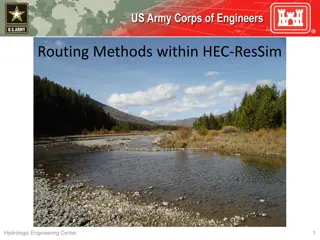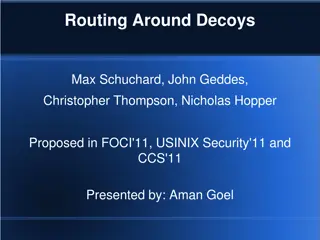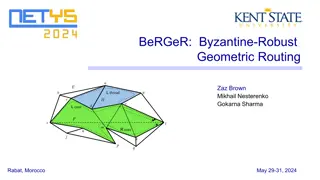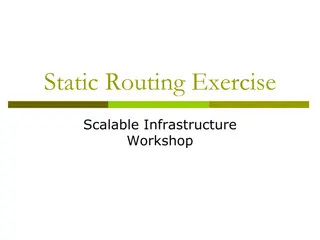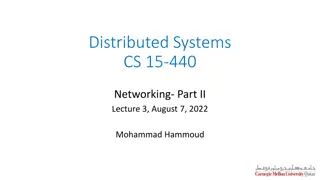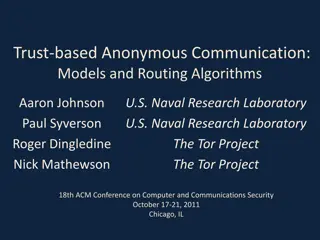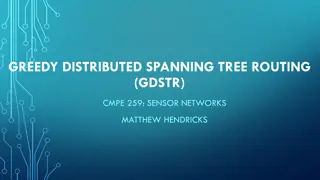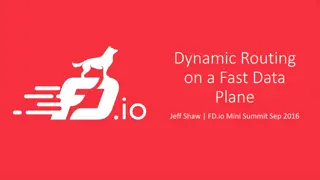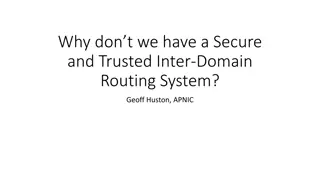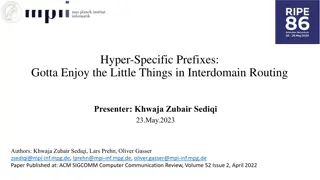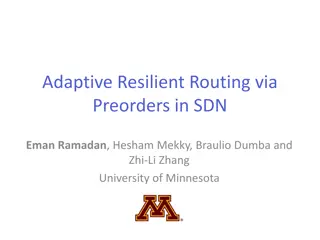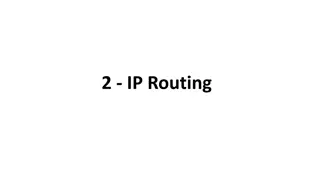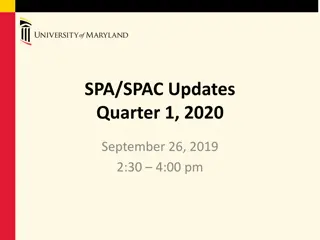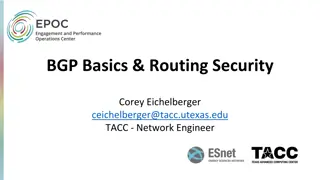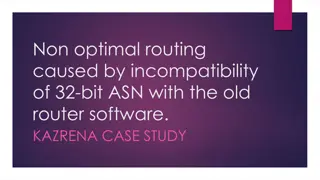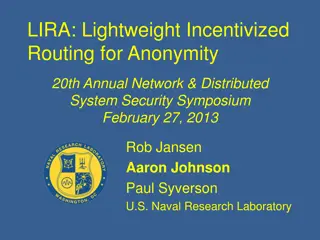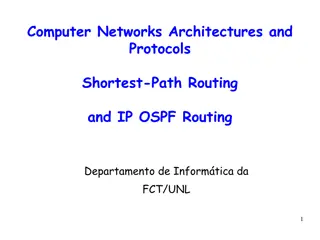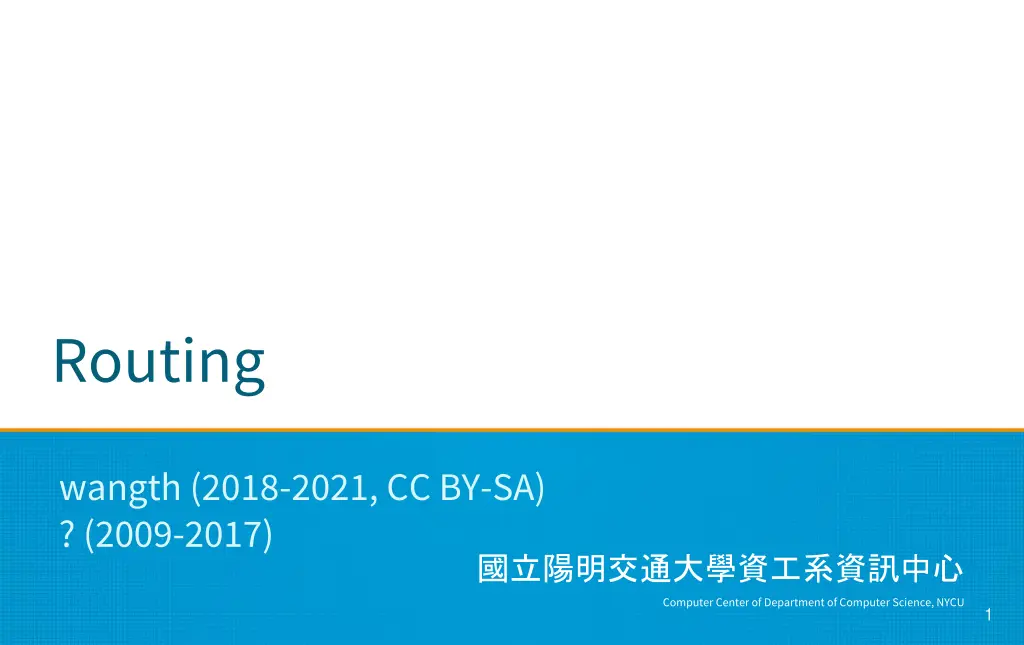
Understanding Network Routing Protocols & Autonomous Systems
Explore the world of network routing protocols, dynamic routing, autonomous systems, AS communication, and the importance of routing protocol usage. Learn about intra-AS and inter-AS routing for efficient data transmission across networks.
Download Presentation

Please find below an Image/Link to download the presentation.
The content on the website is provided AS IS for your information and personal use only. It may not be sold, licensed, or shared on other websites without obtaining consent from the author. If you encounter any issues during the download, it is possible that the publisher has removed the file from their server.
You are allowed to download the files provided on this website for personal or commercial use, subject to the condition that they are used lawfully. All files are the property of their respective owners.
The content on the website is provided AS IS for your information and personal use only. It may not be sold, licensed, or shared on other websites without obtaining consent from the author.
E N D
Presentation Transcript
Routing wangth (2018-2021, CC BY-SA) ? (2009-2017) Computer Center of Department of Computer Science, NYCU 1
Why dynamic route ? (1) Static route is ok only when Network is small There is a single connection point to other network No redundant route X A 192.34.56.0 B A B C 10.1.0.0 (Stub) 2
Why dynamic route ? (2) Dynamic Routing Routers update their routing table with the information of adjacent routers Dynamic routing need a routing protocol for such communication Advantage They can react and adapt to changing network condition A B D C 3
Routing Protocol Used to change the routing table according to various routing information Specify detail of communication between routers Specify information changed in each communication Network reachability Network state Metric Metric A measure of how good a particular route Hop count, bandwidth, delay, load, reliability, Each routing protocol may use different metric and exchange different information 4
Autonomous System Autonomous System (AS) Internet is organized into a collection of autonomous system An AS is a collection of networks with same routing policy Single routing protocol Normally administered by a single entity Corporation or university campus All depend on how you want to manage routing Peering AS 100 AS 101 AS 100 AS 102 5
Category of Routing Protocols by AS AS-AS communication Communications between routers in different AS Interdomain routing protocols Exterior gateway protocols (EGP) Ex: BGP (Border Gateway Protocol) Inside AS communication Communication between routers in the same AS Intradomain routing protocols Interior gateway protocols (IGP) Ex: RIP (Routing Information Protocol) IGRP (Interior Gateway Routing Protocol) OSPF (Open Shortest Path First Protocol) Peering AS 101 AS 100 AS 102 6
Intra-AS and Inter-AS routing Inter-AS routing between A and B C.b B.a Host h2 A.a b A.c a c C a b B a c d Host h1 A b Intra-AS routing within AS A network layer Intra-AS routing algorithm Intra-AS routing algorithm Inter-AS, Intra- AS routing in gateway A.c link layer ROUTING TABLE physical layer DL DL DL to/from A.b to/from B.a PHY PHY PHY 7 to/from A.d
Category of Routing Protocols by information changed (1) Distance-Vector Protocol Message contains a vector of distances, which is the cost to other network Each router updates its routing table based on these messages received from neighbors Protocols RIP IGRP BGP W W X Y Z A B C Routing Table of A Routing Table of B Routing Table of C 0 X 0 Y 0 X 0 Y 0 Z 0 Y 1 Z 1 W 1 Z 2 W 1 W 1 8
Category of Routing Protocols by information changed (2) Link-State Protocol Broadcast their link state to neighbors and build a complete network map at each router using Dijkstra algorithm Protocol OSPF W X Y Z A B C Routing Table of A Routing Table of B Routing Table of C W 0 X 0 Y 0 X 0 Y 0 Z 0 SPF SPF SPF 9
Difference between Distance-Vector and Link-State Difference Distance-Vector Updates neighbor (propagate new info.) Propagation delay cause slow convergence Simple Link-State Update all nodes Update Fast convergence Convergence Complex Complexity Information update sequence B A B A B Distance-Vector Link-State B 10
Routing Protocols RIP IGP,DV IGRP IGP,DV OSPF IGP,LS BGP EGP Computer Center of Department of Computer Science, NYCU 11
RIP RIP Routing Information Protocol Category Interior routing protocol Distance-vector routing protocol Using hop-count as the cost metric Example of how RIP advertisements work Destination network 30 Next router # of hops to destination 4 Destination network 1 Next router # of hops to destination 2 Destination network 1 Next router # of hops to destination 2 C A A 1 -- 1 20 B 2 20 B 2 10 -- 1 30 A 5 30 B 7 Routing table in router before Receiving advertisement Advertisement from router A Routing table after receiving advertisement 12
RIP -Example Another Example N2 = 1 hop N1 ends up with a route to N3 through R2 with hop count to 2 R1 N3 = 1 hop N2 N2 = 1 hop ends up with a route to N1 through R1 with hop count to 2 R1 N3 N2 = 1 hop 13
RIP Message Format RIP message is carried in UDP datagram Command: 1 for request and 2 for reply Version: 1 or 2 (RIP-2) 0 15 16 31 command (1-6) version (1) (must be zero) 20 bytes per route entry address family (2) (must be zero) 32-bit IP address (must be zero) 20 bytes (must be zero) metric (1-16) (up to 24 more routes, with same format as previous 20 bytes) 14
RIP Operation routed RIP routing daemon Operated in UDP port 520 Operation Initialization Probe each interface send a request packet out each interface, asking for other router s complete routing table Request received Send the entire routing table to the requestor Response received Add, modify, delete to update routing table Regular routing updates Router sends out their routing table to every neighbor every 30 seconds Triggered updates Whenever a route entry s metric change, send out those changed part routing table 15
RIP Problems of RIP Issues 15 hop-count limits Take long time to stabilize after the failure of a router or link No CIDR RIP-2 EGP support AS number CIDR support 0 15 16 3 1 command (1-6) version (2) routering domain address family (2) route tag 32-bit IP address 32-bit subnet mask 20 bytes 32-bit next-hop IP address metric (1-16) (up to 24 more routes, with same format as previous 20 bytes) 16
IGRP (1) IGRP Interior Gateway Routing Protocol Similar to RIP Interior routing protocol Distance-vector routing protocol Difference between RIP Complex cost metric other than hop count delay time, bandwidth, load, reliability The formula Use TCP to communicate routing information Cisco System s proprietary routing protocol 17
IGRP (2) Advantage over RIP Control over metrics Disadvantage Still classful and has propagation delay 18
OSPF (1) OSPF Open Shortest Path First Category Interior routing protocol Link-State protocol Each interface is associated with a cost Generally assigned manually The sum of all costs along a path is the metric for that path Neighbor information is broadcast to all routers Each router will construct a map of network topology Each router run Dijkstra algorithm to construct the shortest path tree to each routers 19
OSPF Dijkstra Algorithm Single Source Shortest Path Problem Dijkstra algorithm use greedy strategy Ex: t x 1 t x t x 1 1 8 10 14 8 8 8 10 10 10 9 9 9 2 3 4 6 2 3 4 6 2 3 4 6 0 0 0 s s s 7 7 7 5 5 5 5 5 7 8 8 8 2 2 2 y z y z y z (a) (b) (c) t x t x t x 1 1 1 8 8 9 8 9 13 10 10 10 9 9 9 2 3 4 6 2 3 4 6 2 3 4 6 0 0 0 7 7 7 5 5 5 5 7 5 7 5 7 2 2 2 y z y z y z 20 (d) (e) (f)
OSPF Summary Advantage Fast convergence CIDR support Multiple routing table entries for single destination, each for one type-of-service Load balancing when cost are equal among several routes Disadvantage Large computation 23
BGP BGP Border Gateway Protocol Exterior routing protocol Now BGP-4 Exchange network reachability information with other BGP systems Routing information exchange Message: Full path of autonomous systems that traffic must transit to reach destination Can maintain multiple route for a single destination Exchange method Using TCP Initial: entire routing table Subsequent update: only sent when necessary Advertise only optimal path Route selection Shortest AS path 24
BGP Operation Example How BGP work The whole Internet is a graph of autonomous systems X > Z Original: X > A > B > C > Z X advertise this best path to his neighbor W W > Z W > X > A > B > C > Z W A B C A B C X Z 25
Routing Protocols Comparison RIP IGRP OSPF BGP4 DV or LS DV DV LS Path Vec TCP/UDP & Port U-520 IP-9 T-89 T-179 Classless No No Yes Yes Updates Per. Per. Both Trig. Load Balance No Yes Yes No Internal / External Int. Int. Int. Ext. Metric Hop Count Load Errors Delay Bandwidth Sum of Int. Cost Short. AS Path 26
routed Computer Center of Department of Computer Science, NYCU 27
routed Routing daemon Speak RIP (v1 and v2) Supplied with most every version of UNIX Two modes Server mode (-s) & Quiet mode (-q) Both listen for broadcast, but server will distribute their information routed will add its discovered routes to kernel s routing table Support configuration file - /etc/gateways Provide static information for initial routing table 28

